display BMW 330i SEDAN 2002 E46 User Guide
[x] Cancel search | Manufacturer: BMW, Model Year: 2002, Model line: 330i SEDAN, Model: BMW 330i SEDAN 2002 E46Pages: 155, PDF Size: 2.24 MB
Page 81 of 155
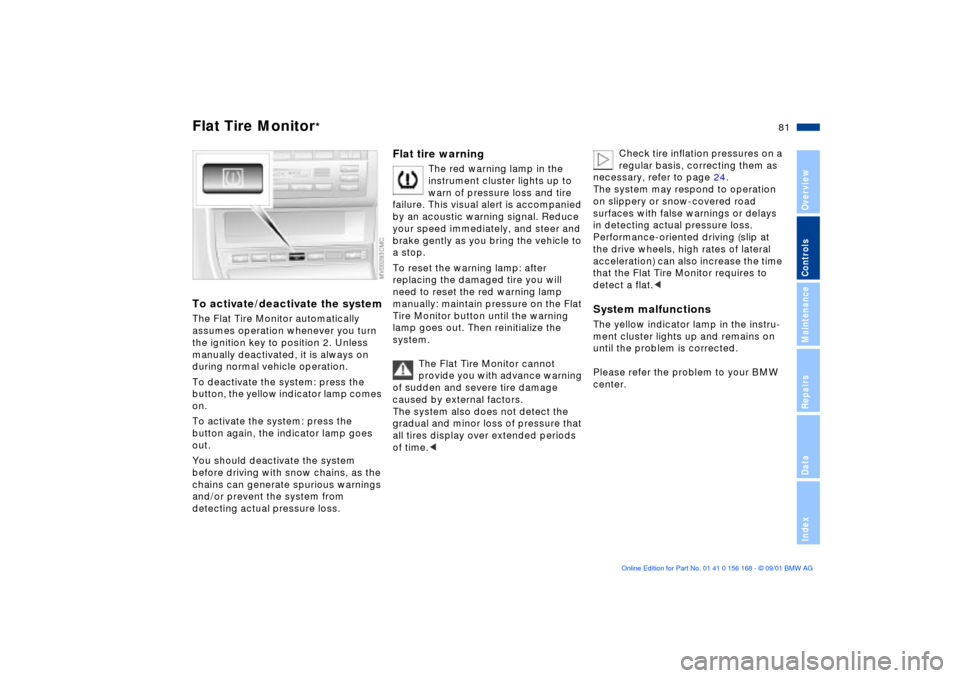
81n
OverviewControlsMaintenanceRepairsDataIndex
Flat Tire Monitor
*
To activate/deactivate the systemThe Flat Tire Monitor automatically
assumes operation whenever you turn
the ignition key to position 2. Unless
manually deactivated, it is always on
during normal vehicle operation.
To deactivate the system: press the
button, the yellow indicator lamp comes
on.
To activate the system: press the
button again, the indicator lamp goes
out.
You should deactivate the system
before driving with snow chains, as the
chains can generate spurious warnings
and/or prevent the system from
detecting actual pressure loss.
Flat tire warning
The red warning lamp in the
instrument cluster lights up to
warn of pressure loss and tire
failure. This visual alert is accompanied
by an acoustic warning signal. Reduce
your speed immediately, and steer and
brake gently as you bring the vehicle to
a stop.
To reset the warning lamp: after
replacing the damaged tire you will
need to reset the red warning lamp
manually: maintain pressure on the Flat
Tire Monitor button until the warning
lamp goes out. Then reinitialize the
system.
The Flat Tire Monitor cannot
provide you with advance warning
of sudden and severe tire damage
caused by external factors.
The system also does not detect the
gradual and minor loss of pressure that
all tires display over extended periods
of time.<
Check tire inflation pressures on a
regular basis, correcting them as
necessary, refer to page 24.
The system may respond to operation
on slippery or snow-covered road
surfaces with false warnings or delays
in detecting actual pressure loss.
Performance-oriented driving (slip at
the drive wheels, high rates of lateral
acceleration) can also increase the time
that the Flat Tire Monitor requires to
detect a flat.<
System malfunctionsThe yellow indicator lamp in the instru-
ment cluster lights up and remains on
until the problem is corrected.
Please refer the problem to your BMW
center.
Page 88 of 155
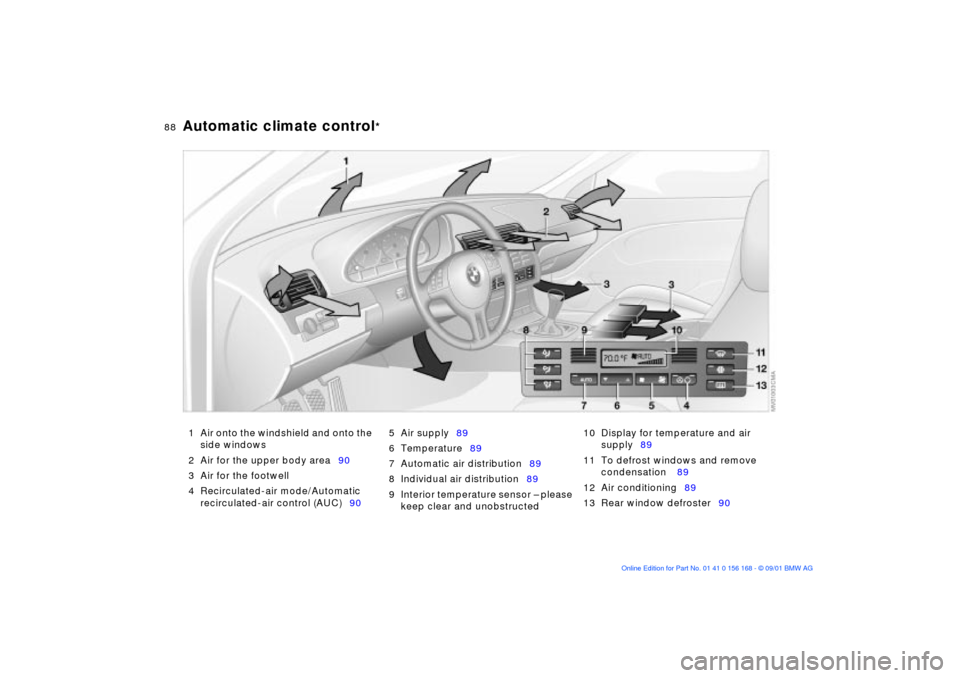
88n
Automatic climate control
*
1 Air onto the windshield and onto the
side windows
2 Air for the upper body area90
3 Air for the footwell
4 Recirculated-air mode/Automatic
recirculated-air control (AUC)905 Air supply89
6 Temperature89
7 Automatic air distribution89
8 Individual air distribution89
9 Interior temperature sensor Ð please
keep clear and unobstructed10 Display for temperature and air
supply89
11 To defrost windows and remove
condensation 89
12 Air conditioning89
13 Rear window defroster90
Page 89 of 155
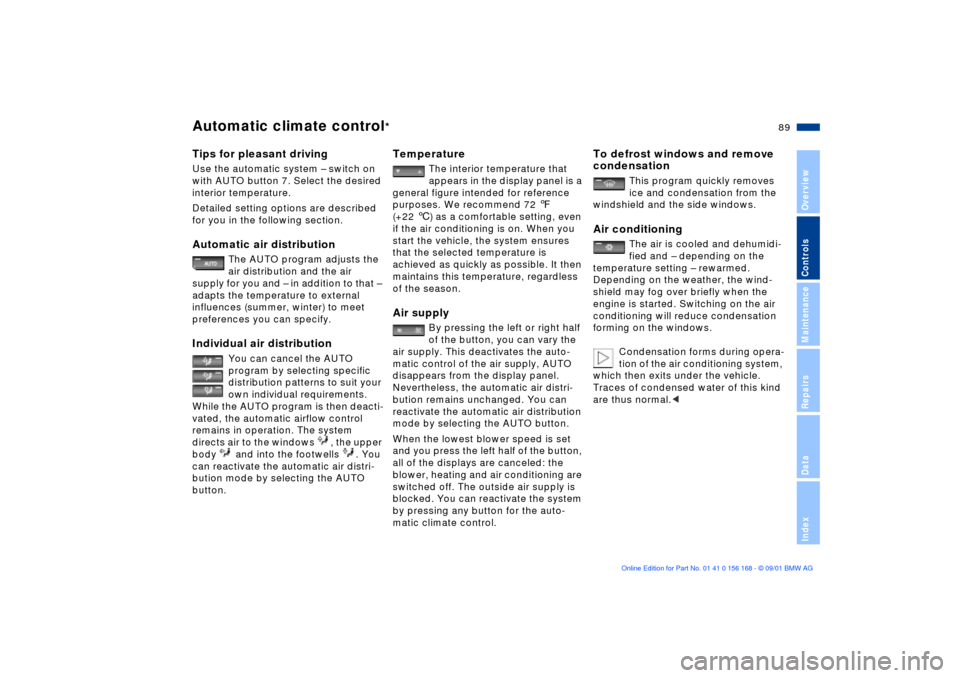
89n
OverviewControlsMaintenanceRepairsDataIndex
Automatic climate control
*
Tips for pleasant drivingUse the automatic system Ð switch on
with AUTO button 7. Select the desired
interior temperature.
Detailed setting options are described
for you in the following section.Automatic air distribution
The AUTO program adjusts the
air distribution and the air
supply for you and Ð in addition to that Ð
adapts the temperature to external
influences (summer, winter) to meet
preferences you can specify.
Individual air distribution
You can cancel the AUTO
program by selecting specific
distribution patterns to suit your
own individual requirements.
While the AUTO program is then deacti-
vated, the automatic airflow control
remains in operation. The system
directs air to the windows , the upper
body and into the footwells . You
can reactivate the automatic air distri-
bution mode by selecting the AUTO
button.
Temperature
The interior temperature that
appears in the display panel is a
general figure intended for reference
purposes. We recommend 72 7
(+22 6) as a comfortable setting, even
if the air conditioning is on. When you
start the vehicle, the system ensures
that the selected temperature is
achieved as quickly as possible. It then
maintains this temperature, regardless
of the season.
Air supply
By pressing the left or right half
of the button, you can vary the
air supply. This deactivates the auto-
matic control of the air supply, AUTO
disappears from the display panel.
Nevertheless, the automatic air distri-
bution remains unchanged. You can
reactivate the automatic air distribution
mode by selecting the AUTO button.
When the lowest blower speed is set
and you press the left half of the button,
all of the displays are canceled: the
blower, heating and air conditioning are
switched off. The outside air supply is
blocked. You can reactivate the system
by pressing any button for the auto-
matic climate control.
To defrost windows and remove
condensation
This program quickly removes
ice and condensation from the
windshield and the side windows.
Air conditioning
The air is cooled and dehumidi-
fied and Ð depending on the
temperature setting Ð rewarmed.
Depending on the weather, the wind-
shield may fog over briefly when the
engine is started. Switching on the air
conditioning will reduce condensation
forming on the windows.
Condensation forms during opera-
tion of the air conditioning system,
which then exits under the vehicle.
Traces of condensed water of this kind
are thus normal.<
Page 111 of 155

111n
OverviewControlsMaintenanceRepairsDataIndex
Winter tiresChoosing the right tireBMW recommends winter tires (M+S
radial tires) for operation under
inclement winter driving conditions.
While all-season tires (M+S designa-
tion) provide better winter traction than
summer tires with the load ratings H, V,
W, Y and ZR, they generally do not
achieve the performance of winter tires.
In the interest of safe tracking and
steering response, install winter tires
made by the same manufacturer having
the same tread configuration on all four
wheels.
Never exceed the maximum
speed for which the winter tires
are rated.
Unprofessional attempts by laymen to
service tires can lead to damage and
accidents.
Have this work performed by trained
professionals only. Any BMW center
has the required technical knowledge
and the proper equipment and will be
happy to assist you.<
Tire condition, tire pressureOnce the tire wears to below 0.16 in
(4 mm), winter tires display a percep-
tible decrease in their ability to cope
with winter driving conditions, and
should be replaced in the interest of
safety.
Comply with the specified tire inflation
pressures Ñ and be sure to have the
wheel and tire assemblies balanced
every time you change the tires.StorageStore tires in a cool, dry place,
protecting them against light whenever
possible. Protect the tires against
contact with oil, grease and fuel.
Snow chains
*
BMW narrow-link snow chains are
intended for mounting on summer or
winter tires in pairs at the rear wheels
only.
BMW 325xi, 330xi: in an extreme emer-
gency Ð for instance, with the vehicle
stuck on one side, or when obstruc-
tions make it impossible to reach one
tire Ð a chain may also be mounted on
just one tire for the limited period
needed to resolve the problem.
Comply with all manufacturer's safety
precautions when mounting the chains.
You cannot mount snow chains on the
following tires:
225/50 R 16 92
225/45 R 17 91
245/40 ZR 17
Page 119 of 155
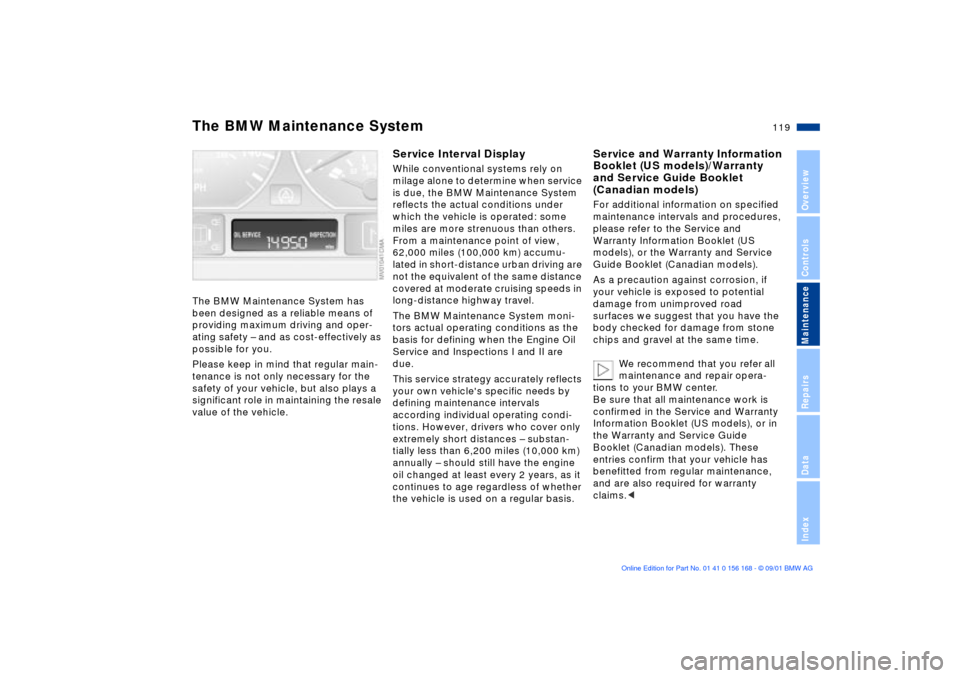
119n
OverviewControlsMaintenanceRepairsDataIndex
The BMW Maintenance System has
been designed as a reliable means of
providing maximum driving and oper-
ating safety Ð and as cost-effectively as
possible for you.
Please keep in mind that regular main-
tenance is not only necessary for the
safety of your vehicle, but also plays a
significant role in maintaining the resale
value of the vehicle.
Service Interval Display
While conventional systems rely on
milage alone to determine when service
is due, the BMW Maintenance System
reflects the actual conditions under
which the vehicle is operated: some
miles are more strenuous than others.
From a maintenance point of view,
62,000 miles (100,000 km) accumu-
lated in short-distance urban driving are
not the equivalent of the same distance
covered at moderate cruising speeds in
long-distance highway travel.
The BMW Maintenance System moni-
tors actual operating conditions as the
basis for defining when the Engine Oil
Service and Inspections I and II are
due.
This service strategy accurately reflects
your own vehicle's specific needs by
defining maintenance intervals
according individual operating condi-
tions. However, drivers who cover only
extremely short distances Ð substan-
tially less than 6,200 miles (10,000 km)
annually Ð should still have the engine
oil changed at least every 2 years, as it
continues to age regardless of whether
the vehicle is used on a regular basis.
Service and Warranty Information
Booklet (US models)/Warranty
and Service Guide Booklet
(Canadian models)
For additional information on specified
maintenance intervals and procedures,
please refer to the Service and
Warranty Information Booklet (US
models), or the Warranty and Service
Guide Booklet (Canadian models).
As a precaution against corrosion, if
your vehicle is exposed to potential
damage from unimproved road
surfaces we suggest that you have the
body checked for damage from stone
chips and gravel at the same time.
We recommend that you refer all
maintenance and repair opera-
tions to your BMW center.
Be sure that all maintenance work is
confirmed in the Service and Warranty
Information Booklet (US models), or in
the Warranty and Service Guide
Booklet (Canadian models). These
entries confirm that your vehicle has
benefitted from regular maintenance,
and are also required for warranty
claims.
<
The BMW Maintenance System
Page 120 of 155

120n
Light-emitting diodes (LEDs)Light-emitting diodes installed behind
translucent lenses serve as the light
source for many of the controls and
displays in your vehicle. These LEDs
operate using a concept related to that
of conventional lasers.
Do not remove the protective lens
and avoid staring directly at the
unfiltered beam for extended periods
(several hours), as inflammation of the
iris could result.<
California laws require us to state the
following warning:
Engine exhaust, some of its
constituents, and certain vehicle
components contain or emit chemicals
known to the State of California to
cause cancer and birth defects or other
reproductive harm.<
Technical modifications California Proposition 65 Warning
Page 147 of 155

Everything from A to Z
147n
OverviewControlsMaintenanceRepairsDataIndex
C
California Proposition
65 Warning120
Capacities143
Car care, refer to the "Caring
for your vehicle" manual
Car key28
Car phone94
refer also to the separate
"Owner's Manual"
Car wash systems, refer to
the "Caring for your
vehicle" manual
Care of upholstery materials,
refer to the "Caring for your
vehicle" manual
Cargo loading99
Cassette operation, refer to
the "Radio Owner's
Manual"
CBC (Cornering Brake
Control)18, 73
CD operation, refer to the
"Radio Owner's Manual"
Cellular phone94
refer also to the separate
"Owner's Manual"94 Center (high-mount) brake
lamp128
Center armrest92
Central locking system28
button32
Changing a wheel/tire129
Check Control68
Checking coolant level117
Checking engine oil
level115
Child-restraint systems52
Clean the headlamps63
Cleaning windshield63
Clock68
refer to the "Radio Owner's
Manual"
Cockpit14
Coin box93
Compartments92
Compression ratio140
Computer69
refer also to the "Onboard
Computer Owner's
Manual"69
Configuring individual
settings via Vehicle and
Key Memory55 Consumption70
display67
Convenience operation via
the door lock
sliding/tilt sunroof31
windows31
Coolant117
add117
capacity143
checking level117
Coolant temperature
gauge67
Cooling system including
heater circuit,
capacity143
Copyright4
Cornering Brake Control
(CBC)18, 73
Correct sitting posture41
Cover, sun blinds91
Cruise control64
Cruising range70
Cup holder, refer to
beverage holder93
Curb monitor47
Curb weight142
Current check indicator17
D
Data
dimensions141
engine140
weights142
Daytime driving lamps82
DBC (Dynamic Brake
Control)73, 74
Deep water105
Defrost windows and
remove
condensation87, 89
Defroster, rear
window86, 90
Digital clock68
Dimensions141
Dipstick, engine oil115
Displacement140
Display lighting83
Displays15
Distance warning71
Divided rear-seat
backrest96
Door key28
Page 148 of 155

Everything from A to ZDoor mirror48
Doors
electrical malfunction31
locking and unlocking29
manual operation31
DOT Quality Grades108
Draft-free ventilation87, 90
Drive belt17
defect17
Driving notes105
DSC (Dynamic Stability
Control)73
indicator lamp19
Dynamic Brake Control
(DBC)73, 74
Dynamic Stability Control
(DSC)73
indicator lamp19 E
Electric power windows37
Electrical malfunction
doors31
fuel filler door22
luggage compartment
lid33
sliding/tilt sunroof40 Elements of operation14
Emergency release of
luggage compartment lid
from luggage
compartment's interior35
Energy control66
Engine compartment
essentials113
Engine coolant, refer to
Coolant117
Engine data140
Engine oil
add115
capacity143
consumption115
level19
level, check115
level, indicator lamp17
pressure17
pressure, indicator
lamp17
Engine, starting56
Engine, switching off57
Exterior mirrors48
F
Failure messages68
Filling capacities143
Fittings, tow starting and
towing135
Flat tire132
Flat Tire
Monitor80, 109, 132
warning lamp17
Flat tires107, 129
Fog lamps83
Follow me home lamps82
Front seat adjustment41
Fuel consumption70
display67
Fuel filler door22
electrical malfunction22
manual operation22
Fuel gauge67
Fuel reserve indicator
lamp67
Fuel specifications23
Fuel tank capacity143
Fuel tank gauge67
Fuel-injection system140
Fuses133
G
Gasoline gauge67
Glove compartment92
Grilles88
Gross vehicle weight142 H
Handbrake58
Hands-free system94
Hazard warning triangle22
HDC (Hill Descent
Control)77
Head restraints44
Headlamp flasher61, 83
Headlamp washer
system114
Headlight control82
Headrests44
Heated seats47
Heavy cargo99
Height141
High beams20, 61, 83
bulb replacement125
Hill Descent Control
(HDC)77
Holder for canned
beverages93
Hood112
Horn14
Page 149 of 155
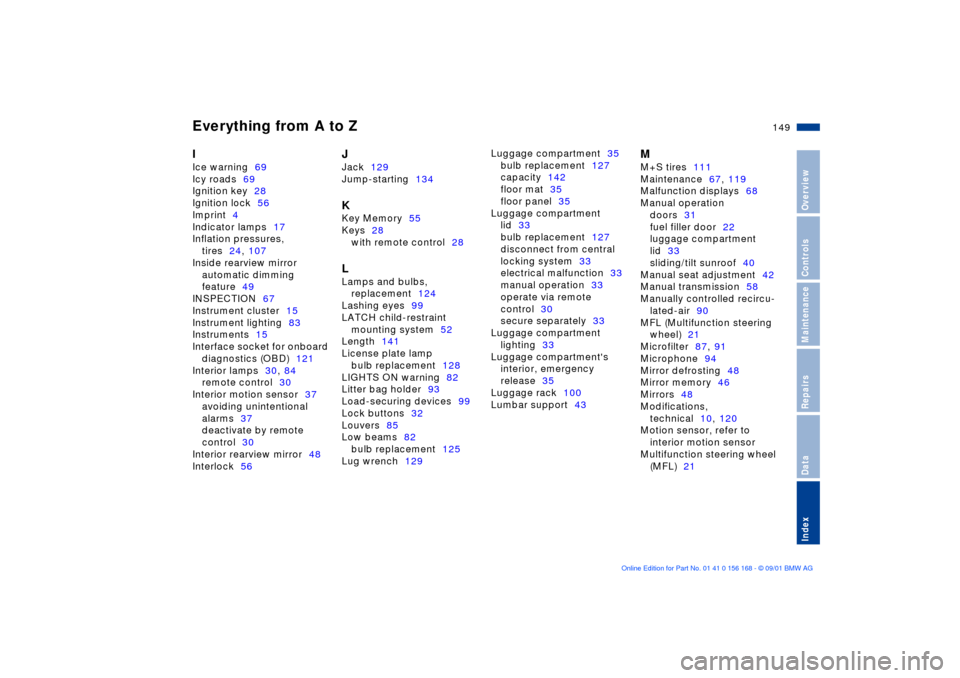
Everything from A to Z
149n
OverviewControlsMaintenanceRepairsDataIndex
I
Ice warning69
Icy roads69
Ignition key28
Ignition lock56
Imprint4
Indicator lamps17
Inflation pressures,
tires24, 107
Inside rearview mirror
automatic dimming
feature49
INSPECTION67
Instrument cluster15
Instrument lighting83
Instruments15
Interface socket for onboard
diagnostics (OBD)121
Interior lamps30, 84
remote control30
Interior motion sensor37
avoiding unintentional
alarms37
deactivate by remote
control30
Interior rearview mirror48
Interlock56
J
Jack129
Jump-starting134 K
Key Memory55
Keys28
with remote control28 L
Lamps and bulbs,
replacement124
Lashing eyes99
LATCH child-restraint
mounting system52
Length141
License plate lamp
bulb replacement128
LIGHTS ON warning82
Litter bag holder93
Load-securing devices99
Lock buttons32
Louvers85
Low beams82
bulb replacement125
Lug wrench129 Luggage compartment35
bulb replacement127
capacity142
floor mat35
floor panel35
Luggage compartment
lid33
bulb replacement127
disconnect from central
locking system33
electrical malfunction33
manual operation33
operate via remote
control30
secure separately33
Luggage compartment
lighting33
Luggage compartment's
interior, emergency
release35
Luggage rack100
Lumbar support43
M
M+S tires111
Maintenance67, 119
Malfunction displays68
Manual operation
doors31
fuel filler door22
luggage compartment
lid33
sliding/tilt sunroof40
Manual seat adjustment42
Manual transmission58
Manually controlled recircu-
lated-air90
MFL (Multifunction steering
wheel)21
Microfilter87, 91
Microphone94
Mirror defrosting48
Mirror memory46
Mirrors48
Modifications,
technical10, 120
Motion sensor, refer to
interior motion sensor
Multifunction steering wheel
(MFL)21
Page 150 of 155

Everything from A to ZN
Navigation system, refer to
the Radio or Onboard
Computer "Owner's
Manual" O
OBD interface socket121
Odometer66
Oil
additives115
capacity143
consumption115
level, checking115
Oil change intervals, refer to
the Service and Warranty
Information Booklet/
Warranty and Service
Guide Booklet
Oil dipstick115
Oil filter change143
OIL SERVICE67
Onboard Computer, refer to
the "Onboard Computer
Owner's Manual"
Onboard tool kit124 Opening and closing
from the inside32
via the door lock31
via the remote control29
Outlets, ventilation88
Outside temperature
display69
P
Paintwork, refer to the
"Caring for your vehicle"
manual
Park assistant71
Park Distance Control
(PDC)71
Parking aid71
Parking brake58
Parking lamps82
bulb replacement125
Passenger-side mirror tilt
function47
PDC (Park Distance
Control)71
Phone, refer to cellular
phone
Power140
Power windows37
safety switch38
Premium sound system91
Q
Quality Grades, tires108 R
Radiator143
Rain sensor62
RDC (Tire Pressure
Monitor)78
warning lamp17
Reading lamps
front84
rear84
Rear center 3-point belt96
Rear lamps127
Rear reading lamps84
Rear window
defroster86, 90
Rear-seat backrest,
removable96
Rearview mirror48
Recirculated-air mode86
Reclining seat41
Refueling22
Remote control29
Removable rear-seat
backrest96
Reporting safety defects11
Roller sun blind91
Roof weight142
Roof-mounted luggage
rack100
S
Safe with safety belts41
Safety belts45
height adjustment45
Safety defects, reporting11
Safety tires109, 132
Seat adjustment41
Seat heating47
Seat memory46
Seat, manually adjusted42
Seats41
Securing cargo99
Securing child-restraint
system54
Selector lever, automatic
transmission59
Service and Warranty Infor-
mation Booklet (US
models)119
Service Interval
Display67, 119
Setting temperature86
Shiftlock59
Side airbags49
Side Impact Head Protection
System49
Sitting correctly with
airbags41
Ski bag97